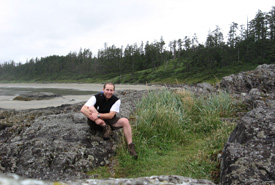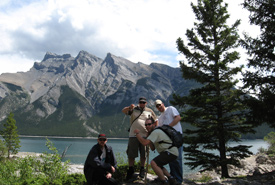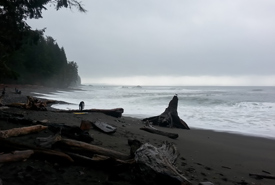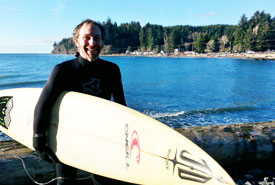Exploring Canada on four wheels

Chris Perrin in Pacific Rim National Park Reserve, BC, 2006. (Photo courtesy Chris Perrin)
I first visited British Columbia in 2006. My brother, our mutual friend and I decided to make an early summer road trip from Montreal to Tofino and back — all in two weeks. There wasn’t any particular reason for the trip other than a desire to see what this country looked like, as the three of us had never been west of Hamilton, Ontario. We chose our dates, and my brother took one look at the map and picked Tofino, BC, as our destination. That, he said, was where we would run out of road.
After 14 long days, we arrived back in Montreal, road-weary and happy to be done with driving. Despite spending no more than 36 hours in Tofino and maybe four days in BC, the seed was planted.
Nine years later, after several adventures and life changes, I found myself back on Vancouver Island, content that this visit was going to be longer than a single night. Having decided on a whim to leave behind the cold, endless winters of the St. Laurent Valley, my partner and I spent another two weeks driving and finally unpacked our van in Victoria, with no expectations to flee.

The crew in Banff National Park, AB, 2006. (Photo courtesy Chris Perrin)
In the two years since, we’ve explored as much as we can of the island’s west coast. We’ve returned to BC’s interior to visit the Nature Conservancy of Canada’s (NCC’s) Darkwoods conservation area, taking ferries between the Gulf Islands and Lower Mainland, doing our best to get to know our new home.
We’ve watched eagles fishing in Clayoquot Sound, helped a tiny otter pup find its mom along a suburban Victoria beach and marvelled at the goats that live on commercial roofs in the city. In many ways, we’re still amazed at the mountains, the sandy (and rocky) beaches, the depth of the rainforests. Yet the boreal and mixed wood plains of Quebec and Ontario remain in our thoughts, their bright autumn leaves still colouring in the edges of memory as they fade toward winter.
Drastically different, the vast territory that makes up Canada’s expanse is in many ways boundless. Ecoregions and ecosystems overlap and mingle, fading slowly into each other. What makes these lands special — what makes any set of lands special, really — is how accessible we find them and how we prioritize our time in them.

Chris on the stormy shores of Sombrio Beach, BC, 2016. (Photo courtesy Chris Perrin)
The abandoned hamlet of Jordan River — a place I had never heard of before moving to BC — now holds a special place in my heart. It’s where I spend at least one day a week during the winter, often passing by its quiet waters while en route to the numerous campsites that dot the road between Victoria and Port Renfrew. It hasn’t replaced any of the special places I’ve left behind — like the canoe routes of the Réserve faunique La Vérendrye or the dark limitless depths of Algonquin Provincial Park. Rather, like all places of natural beauty that affect us, it has come to represent my being here, on the west coast, at this time in my life.
Each of these places can be neglected, left to fade from memory, to lose their importance. The choice is to not turn from them, not to hold one as more important than the other, but to prioritize our time in nature, and to find the tranquility that comes from a morning hike or a late-afternoon picnic on the beach. Make a place special, to you and your family — one that you can drive or walk to — and you’ll see that spending time surrounded by nature isn’t so impossible.
It’s so easy, it’s natural.


